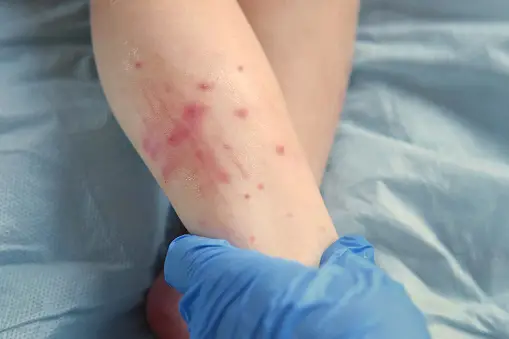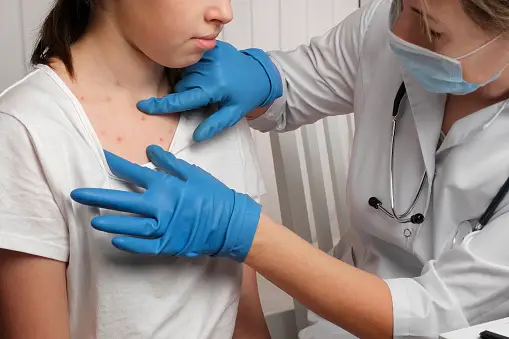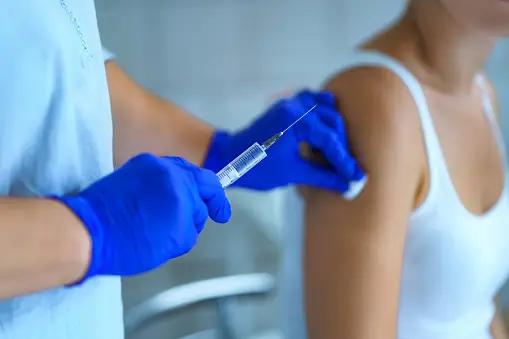Measles, also known as rubeola, is a highly contagious viral disease that primarily affects children but can also impact adults. Caused by the measles virus, it spreads through respiratory droplets from coughs or sneezes of infected individuals. Measles is characterized by symptoms such as high fever, cough, runny nose, inflamed eyes, and a distinctive red rash that typically begins on the face and spreads downward across the body.
Despite the availability of an effective vaccine, measles remains a significant public health concern, especially in areas with low vaccination rates. The disease can lead to severe complications, including pneumonia, encephalitis, and death, particularly among young children and immunocompromised individuals. Understanding measles, its transmission, symptoms, and the importance of vaccination is crucial in preventing outbreaks and protecting public health.
Table of Contents
Symptoms of Measles

Measles presents a range of symptoms that typically appear 7-14 days after exposure to the virus. The progression of symptoms usually follows a characteristic pattern:
Early Symptoms (Prodromal Phase)
- Fever: A high fever is often the first sign of measles, typically above 101°F (38.3°C).
- Cough: A persistent, dry cough develops early in the infection.
- Runny Nose: Nasal congestion and a runny nose are common initial symptoms.
- Red, Watery Eyes (Conjunctivitis): Inflammation of the eyes, making them red and sensitive to light.
Later Symptoms
- Koplik Spots: Small, white spots with a bluish-white center on a red background, appearing inside the mouth, particularly on the inner lining of the cheeks. These are a hallmark of measles and appear 2-3 days before the rash.
- Rash: A red, blotchy rash that starts on the face, especially around the hairline and behind the ears, and then spreads downward to the trunk, arms, and legs. The rash typically lasts 5-6 days and fades in the same order it appeared.
- High Fever: The fever may spike again as the rash spreads over the body.
Additional Symptoms
- Sore Throat: Discomfort and pain in the throat.
- Swollen Lymph Nodes: Swelling of the lymph nodes in the neck.
- Body Aches: Generalized discomfort and muscle aches.
Recognizing the symptoms of measles is crucial for early diagnosis and treatment. If you or someone you know exhibits these symptoms, especially in conjunction with known exposure to the virus or lack of vaccination, it is important to seek medical attention promptly. Vaccination remains the most effective way to prevent measles and its complications.
Causes of Measles

Measles is caused by the measles virus, a highly contagious pathogen that belongs to the paramyxovirus family. The virus primarily infects the respiratory tract and spreads through respiratory droplets. Here’s a detailed look at the causes of measles:
Transmission
- Person-to-Person Contact: Measles is primarily spread through direct contact with infectious droplets released into the air when an infected person coughs, sneezes, or talks.
- Airborne Transmission: The virus can remain viable and airborne for up to two hours in the environment where an infected person has coughed or sneezed, making it possible to contract the virus by breathing contaminated air.
- Surface Contamination: Less commonly, the virus can spread by touching a surface contaminated with infectious droplets and then touching the mouth, nose, or eyes.
High Contagiousness
- Infectious Period: An individual with measles is contagious from about four days before the onset of the rash to four days after the rash appears.
- Attack Rate: Measles has a high attack rate, meaning that 90% of non-immune individuals exposed to the virus will become infected.
Risk Factors
- Lack of Vaccination: Individuals who have not received the measles, mumps, and rubella (MMR) vaccine are at high risk of contracting the virus.
- Weakened Immune System: People with weakened immune systems, including those with HIV/AIDS, cancer, or those taking immunosuppressive medications, are more susceptible to severe measles infections.
- Infants: Babies younger than 12 months, who are too young to receive the measles vaccine, are particularly vulnerable.
- Travel: Traveling to or from areas where measles is endemic or where vaccination rates are low increases the risk of exposure.
Factors Promoting Transmission
- High Population Density: Crowded living conditions can facilitate the spread of the virus.
- International Travel: Measles can spread rapidly through international travel, as infected individuals can carry the virus to different regions.
The primary cause of measles is the highly contagious measles virus, which spreads through respiratory droplets. Factors such as lack of vaccination, weakened immune systems, and travel to endemic areas increase the risk of infection. Preventative measures, especially vaccination, are crucial in controlling the spread of measles and protecting public health.
Diagnosis of Measles

Diagnosing measles involves a combination of clinical evaluation, laboratory tests, and consideration of the patient’s history and symptoms. Here’s a detailed overview of the diagnostic process:
Clinical Evaluation
- Medical History: A thorough history is taken to identify potential exposure to the measles virus, vaccination status, and any recent travel to areas with ongoing outbreaks.
- Symptom Assessment: Physicians look for classic symptoms of measles, including high fever, cough, runny nose, conjunctivitis (red, watery eyes), and the characteristic red rash that starts on the face and spreads downward.
Physical Examination
- Koplik Spots: One of the key diagnostic signs is the presence of Koplik spots—tiny white spots with bluish-white centers found inside the mouth on the inner lining of the cheek. These appear 2-3 days before the rash.
- Rash: The rash usually starts on the face and behind the ears before spreading to the trunk, arms, and legs. The rash consists of flat red spots that can merge, forming larger blotches.
Laboratory Tests
- Serological Tests:
- Measles-Specific IgM Antibodies: A blood test can detect the presence of IgM antibodies specific to the measles virus, which typically appear within a few days of the rash onset and remain detectable for several weeks.
- Measles-Specific IgG Antibodies: A follow-up test can measure IgG antibodies to confirm immunity or past infection.
- Polymerase Chain Reaction (PCR):
- Throat Swab, Nasopharyngeal Swab, or Urine Sample: PCR testing can detect measles RNA from these samples, providing a definitive diagnosis. This test is particularly useful in the early stages of the disease.
Differential Diagnosis
Physicians must distinguish measles from other conditions with similar symptoms, such as:
- Rubella (German Measles): Similar rash but typically milder symptoms.
- Roseola: High fever followed by a rash as the fever subsides.
- Scarlet Fever: Rash accompanied by a sore throat and high fever caused by streptococcal bacteria.
- Kawasaki Disease: Rash, fever, and inflammation of blood vessels, primarily affecting young children.
- Dengue Fever: A mosquito-borne viral illness with a rash and fever.
Diagnosing measles involves a combination of clinical evaluation, identification of characteristic signs such as Koplik spots and rash, and confirmation through laboratory tests, including serology and PCR. Prompt and accurate diagnosis is crucial for effective management and preventing the spread of this highly contagious disease.
Treatment

Treating measles primarily involves supportive care to alleviate symptoms and manage complications, as there is no specific antiviral treatment for the measles virus itself. Here is a detailed overview of the treatment options for measles:
Supportive Care
- Fever Management:
- Antipyretics: Medications like acetaminophen (Tylenol) or ibuprofen (Advil) can help reduce fever and relieve pain.
- Hydration: Ensure adequate fluid intake to prevent dehydration, especially in cases with high fever and diarrhea.
- Rest: Encourage rest to help the body fight off the infection.
- Cough and Respiratory Symptoms:
- Humidifier: Using a cool-mist humidifier can help soothe irritated airways and reduce coughing.
- Hydration: Drinking plenty of fluids can also help keep the throat moist and reduce coughing.
- Eye Care:
- Conjunctivitis Relief: Gently clean crust from the eyes with a warm, damp cloth. Keeping the room dimly lit can help with light sensitivity.
- Rash Care:
- Comfort: Keep the skin clean and dry. Loose, comfortable clothing can help reduce irritation from the rash.
Vitamin A Supplementation
- Dosage: The World Health Organization (WHO) recommends vitamin A supplementation for all children diagnosed with measles, as it can help prevent severe complications and reduce mortality rates.
- Administration: Administered in two doses, 24 hours apart. The dose depends on the child’s age:
- 200,000 IU for children aged 12 months and older
- 100,000 IU for infants aged 6-11 months
- 50,000 IU for infants younger than 6 months
The treatment of measles focuses on supportive care to relieve symptoms and manage complications. Vitamin A supplementation is crucial for children to reduce the severity of the disease. Preventing the spread of measles through isolation and public health measures is essential to control outbreaks. Prompt medical attention and supportive care can significantly improve outcomes for individuals with measles.
Prevent

Preventing measles is primarily achieved through vaccination, along with public health measures to control outbreaks and protect vulnerable populations. Here is a comprehensive overview of strategies to prevent measles:
Vaccination
- Measles, Mumps, and Rubella (MMR) Vaccine:
- First Dose: The first dose of the MMR vaccine is typically administered to children between 12 and 15 months of age.
- Second Dose: A second dose is given between 4 and 6 years of age, before the start of school. This ensures long-lasting immunity.
- Effectiveness: Two doses of the MMR vaccine are about 97% effective at preventing measles.
- Catch-Up Vaccination: Unvaccinated individuals and those who missed one or both doses should receive the vaccine as soon as possible, regardless of age.
- MMRV Vaccine:
- Combination Vaccine: In some regions, the MMR vaccine is combined with the varicella (chickenpox) vaccine, known as the MMRV vaccine, offering protection against all four diseases.
Immunization Campaigns
- Public Health Campaigns: Mass immunization campaigns, especially in areas with low vaccination coverage, are crucial in preventing outbreaks.
- School and Daycare Requirements: Ensuring that children meet vaccination requirements for school and daycare attendance can help maintain high levels of community immunity.
Herd Immunity
- Community Protection: High vaccination rates create herd immunity, which helps protect those who cannot be vaccinated, such as infants, pregnant women, and individuals with weakened immune systems.
Public Health Measures
- Surveillance and Reporting:
- Disease Monitoring: Continuous monitoring and rapid reporting of measles cases help detect and respond to outbreaks quickly.
- Contact Tracing: Identifying and notifying individuals who have been in contact with a measles patient can prevent further spread.
- Isolation of Infected Individuals:
- Home Isolation: Infected individuals should stay at home and avoid contact with others from the onset of symptoms until at least four days after the rash appears.
- Hospital Precautions: In healthcare settings, patients with measles should be isolated in negative-pressure rooms to prevent airborne transmission.
Hygiene Practices
- Hand Hygiene: Regular hand washing with soap and water or using hand sanitizer can reduce the spread of infections.
- Respiratory Etiquette: Covering the mouth and nose with a tissue or elbow when coughing or sneezing helps prevent the spread of respiratory droplets.
Travel Precautions
- Vaccination Before Travel: Individuals traveling to areas with ongoing measles outbreaks should ensure they are fully vaccinated. Infants as young as 6 months may receive an early dose of the MMR vaccine if traveling to high-risk areas.
- Awareness: Travelers should be aware of measles outbreaks and take necessary precautions, including avoiding close contact with sick individuals.
Education and Awareness
- Community Outreach: Public health authorities should engage in community outreach to educate about the importance of vaccination and measles prevention.
- Counteracting Misinformation: Addressing vaccine misinformation and promoting factual information about the safety and efficacy of the MMR vaccine is essential.
Preventing measles relies on widespread vaccination with the MMR vaccine, public health measures to control outbreaks, and education to promote vaccine acceptance. High vaccination coverage creates herd immunity, protecting the entire community, especially vulnerable individuals. Adhering to these prevention strategies can significantly reduce the incidence of measles and prevent outbreaks.
Complications

Measles can lead to a range of complications, some of which are severe and potentially life-threatening. These complications are more common in certain groups, such as young children, adults over the age of 20, pregnant women, and individuals with weakened immune systems. Here is a detailed overview of the possible complications associated with measles:
Common Complications
- Diarrhea:
- Frequent and watery bowel movements, which can lead to dehydration, especially in young children.
- Ear Infections (Otitis Media):
- Bacterial infections of the middle ear are common and can result in pain and, in some cases, temporary hearing loss.
Serious Complications
- Pneumonia:
- Primary Viral Pneumonia: Caused directly by the measles virus, leading to inflammation and infection of the lungs.
- Secondary Bacterial Pneumonia: Bacterial superinfection following measles, requiring antibiotic treatment. Pneumonia is the most common cause of death in young children with measles.
- Encephalitis:
- Acute Encephalitis: Inflammation of the brain occurring in about 1 in 1,000 cases, which can cause seizures, permanent brain damage, or death.
- Subacute Sclerosing Panencephalitis (SSPE): A rare, fatal degenerative disease of the central nervous system that can occur 7-10 years after measles infection. It is more common in individuals who contracted measles at a young age.
Pregnancy-Related Complications
- Miscarriage:
- Increased risk of spontaneous abortion in pregnant women who contract measles.
- Premature Birth:
- Higher likelihood of giving birth prematurely.
- Low Birth Weight:
- Infants born to mothers who had measles during pregnancy may have lower birth weights.
Immune System Impact
- Immune Amnesia:
- Measles can weaken the immune system for months to years, making individuals more susceptible to other infections by erasing immune memory of previously encountered pathogens.
Less Common Complications
- Hepatitis:
- Inflammation of the liver.
- Appendicitis:
- Inflammation and infection of the appendix.
- Thrombocytopenia:
- A reduction in platelets, which can lead to bleeding and bruising easily.
Long-Term Effects
- Severe Malnutrition:
- Measles can exacerbate malnutrition, especially in children in developing countries, leading to growth retardation and increased vulnerability to other diseases.
- Disability:
- Severe cases of measles can result in long-term disabilities, such as blindness, hearing loss, or intellectual disabilities.
Measles is not just a mild childhood illness; it can lead to a wide range of serious complications, particularly in vulnerable populations. The best way to prevent these complications is through vaccination with the MMR vaccine, which provides effective protection against measles. Early detection and supportive care are crucial for managing measles and reducing the risk of severe outcomes. Public health measures, including maintaining high vaccination coverage and rapid response to outbreaks, are essential in preventing the spread of measles and its associated complications.
Conclusion
In conclusion, measles is a highly contagious viral disease with significant health risks, particularly for young children, pregnant women, and individuals with weakened immune systems. Despite being preventable through vaccination, measles continues to pose a public health challenge in areas with low immunization rates. Understanding the symptoms, causes, and complications of measles is crucial for effective prevention, early diagnosis, and appropriate treatment.
Vaccination with the MMR (measles, mumps, and rubella) vaccine is the most effective way to prevent measles and its severe complications. Maintaining high vaccination coverage is essential for achieving herd immunity, protecting those who cannot be vaccinated, and preventing outbreaks. Public health efforts, including surveillance, rapid outbreak response, and education campaigns, play a vital role in controlling the spread of measles.
Awareness and education about measles, its transmission, and the importance of vaccination can help dispel myths and reduce vaccine hesitancy. By working together to promote vaccination and public health measures, we can significantly reduce the incidence of measles and protect communities worldwide from this potentially deadly disease.
